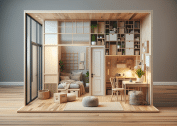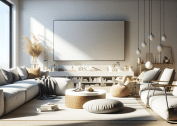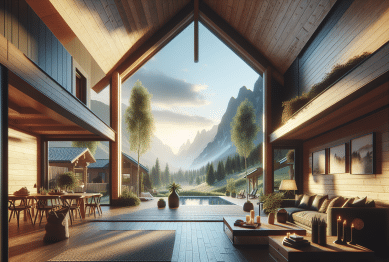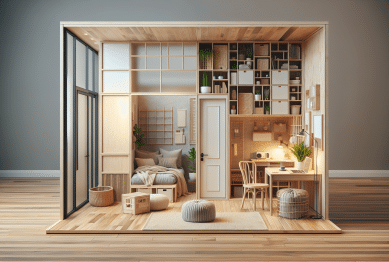Unlock creative living room décor ideas that make any space feel inviting and unique. This guide explores affordable interior design trends, color concepts, and lighting effects to help you personalize your own entertainment hub and showcase authentic style in your home.
Personalizing Your Living Room for Maximum Comfort
Personalizing your living room means a lot more than just picking matching furniture sets. Many people want their living room to be both functional and welcoming. To start, consider introducing elements that tell your story, such as family photos, inherited vases, or souvenirs from memorable trips. What makes this approach so appealing is its focus on individuality—a space that truly feels like your own instantly increases comfort. Whether arranging bookshelves or displaying collections, these personal details can transform bare rooms into cozy retreats. Psychology studies suggest that familiar items reduce stress and improve relaxation, making your living room the ideal place to unwind (https://www.apa.org/monitor/2011/04/home).
Layering different textiles is another effective technique to personalize any living space. Think plush area rugs, decorative pillows, or a knitted throw blanket—each detail adds texture and color while making the room feel warm and inviting. Beyond aesthetics, textiles also provide practical comfort. They can dampen noise and create a cozy nook perfect for reading or watching movies. Mixing patterns, from floral prints to geometric designs, brings energy and life to any room. These small changes can help you refresh the ambiance while being mindful of budget and sustainability by upcycling or thrifting materials.
Don’t underestimate the value of flexible furniture arrangements when customizing your living room. Modular sofas, moveable ottomans, and lightweight tables let you switch up your setup on a whim. These adaptable options accommodate guests or create extra floor space for everyday routines. This flexibility is especially useful in apartments or smaller homes, where efficient space usage is crucial. Research from leading design institutes highlights how flexible environments improve well-being by adapting swiftly to changing needs (https://www.architecture.com/knowledge-and-resources/resources-landing-page/home-design-ideas).
Current Trends in Living Room Décor
Staying informed about interior design trends offers inspiration for reinventing your personal space. Earthy tones like sage green, terracotta, and sand are now dominating living room color palettes, providing a calm foundation that supports a wide range of style preferences. Houseplants, once seen as accessories, have become design essentials for their vibrant look and natural air-purifying qualities. Adding greenery brings both physical health benefits and visual interest, offering an easy and sustainable way to rejuvenate your décor (https://www.ncbi.nlm.nih.gov/pmc/articles/PMC4419447/).
Multifunctional furniture is capturing the spotlight as more lifestyles require spaces to serve multiple purposes—especially for those working or studying from home. Sofa beds, nesting tables, and convertible shelving solutions combine practicality with style. Incorporating these pieces creates a living zone that easily shifts from movie nights to meetings or hobby spaces, proving that adaptability is central to modern comfort. Designers have found that well-chosen multipurpose furniture can help reduce clutter and stress in everyday life.
Bringing in personal artwork and handmade objects is another popular trend. Whether you showcase original paintings or support local artisans, unique wall art makes your living room stand out. Gallery walls arranged with personal photography and prints inject character and serve as conversation starters. No matter the chosen style—minimalist, boho, or eclectic—a curated display creates lasting visual impact while expressing your authentic taste in entertainment and leisure environments.
The Role of Lighting and Color Psychology
Lighting can make or break the mood of your living room. Natural light opens spaces and brightens colors, but strategic artificial lighting is equally crucial after sunset. Layering different lighting types—ambient, task, and accent—lets you set the tone for any occasion. Table lamps with warm bulbs encourage relaxation, while statement ceiling fixtures draw the eye and add sophistication. Even small changes, like updating lamp shades or using longer-lasting LED bulbs, can make a significant difference to both atmosphere and energy efficiency (https://www.energy.gov/eere/buildings/articles/lighting-design-best-practices).
Color psychology plays a subtle yet powerful role in how a living room feels. Cool hues like blue and green promote calm, while warmer tones such as mustard or rust stimulate conversation and creativity. Painting a single accent wall or introducing colorful accessories with throws and rugs can refresh the room without commitment to a full overhaul. A successful color scheme balances elements for both tranquility and vibrancy, complementing your individual taste and encouraging social connections. Interior designers advise experimenting with samples to discover which shades create the desired mood for your home and entertainment space.
Accent lighting, like under-shelf LEDs or picture lights, enhances architectural features and highlights art or favorite décor objects. Dimmer switches provide versatility so you can easily switch from lively family gatherings to quiet nights with a book. Choosing lighting that matches daily rhythms supports relaxation and can improve sleep patterns, as well as overall mental wellness, according to sleep and wellness experts (https://sleepfoundation.org/bedroom-environment/light).
Organizing for Style, Function, and Wellness
Organization isn’t just about tidiness. A thoughtfully arranged living room creates a sense of calm and helps routines function more smoothly. Storage solutions like hidden cabinets, stackable baskets, or stylish bins keep items accessible but out of sight. These elements declutter the environment, facilitating a clearer mind and a more enjoyable entertainment experience. Professional organizers often stress the importance of regular decluttering as part of a well-being routine, which also supports healthier indoor air quality (https://www.cdc.gov/healthyhomes/bytopic/clutter.html).
Establishing dedicated zones for activities—such as reading, gaming, or hosting guests—helps maximize even small living rooms. A bookshelf with a cozy chair can signal a reading nook, while a rolling bar cart defines a spot for socializing. Creating visual boundaries using area rugs, lighting, or room dividers keeps different functions distinct without complicated remodeling. This zoning inspires frequent, purposeful use of every corner and boosts your enjoyment of home entertainment and leisure.
Incorporating wellness features is increasingly common in lifestyle-oriented design. Himalayan salt lamps, aromatherapy diffusers, and indoor air-purifying plants like snake or spider plants contribute to an inviting environment. These subtle touches support physical and mental well-being while blending seamlessly with décor. Many families are now seeking such healthy design elements alongside their pursuit of stylish, functional living spaces. Small choices—such as eco-friendly paint or organic cotton blankets—allow you to live well while expressing personal taste.
Entertainment and Technology Integration
Home entertainment options can deeply influence how you use and enjoy your living room. Integrated audio-visual setups, streaming devices, and smart speakers are more accessible than ever. Creating a movie night experience or a casual music zone is as much about thoughtful layout as it is about equipment selection. Hiding cords with cable channels and storing remotes in dedicated baskets keeps spaces neat and makes technology blend into the design instead of standing out as clutter (https://www.cnet.com/home/smart-home/ways-to-hide-cords-in-your-home/).
Smart lighting, like programmable bulbs or voice-activated fixtures, gives you ultimate control over ambiance. Setting scenes for movie time or adjusting brightness for game night personalizes your experience while reducing energy waste. Many systems are easy to install and compatible with major smart home platforms, supporting modern lifestyles with both convenience and flair. As technology evolves, simple upgrades make it possible to update entertainment zones without full renovations.
Blending technology with traditional design elements requires balance. Displaying vintage music collections, like vinyl records or classic books, beside sleek digital devices can create an eclectic yet harmonious look. The goal is not to hide technology entirely but to incorporate it in a way that enhances daily life while maintaining a cozy and visually appealing setting. Design experts recommend using furniture with built-in charging stations and concealed storage to keep innovation seamless and rooms clutter-free.
Sustainable and Budget-Friendly Living Room Makeovers
Achieving a new look doesn’t require big spending or frequent purchases. Repurposing furniture, swapping items between rooms, or simply updating hardware like handles and drawer pulls creates noticeable visual improvements with little investment. Shopping at local thrift stores and upcycling old finds has also become a popular trend, helping homeowners personalize décor while being mindful of environmental impact (https://www.epa.gov/recycle/reducing-waste-what-you-can-do).
Embracing do-it-yourself projects is both rewarding and practical. Simple DIY artwork, hand-painted pots, or refurbished lamp bases infuse spaces with personality unique to your household. Numerous online resources offer guidance on mindful spending, highlighting projects that support creative, affordable upgrades. The process of crafting and customizing décor can also be a fun, shared entertainment activity for families or roommates, strengthening bonds and building memories at home.
Donating or selling items you no longer use completes the cycle of sustainable living room renewal. Community swap events or online marketplaces provide platforms to pass on gently used pieces, promoting reduced waste. Even small changes—rotating pillow covers, changing curtains, or adding seasonal décor—can protect your budget and refresh your living room year-round. Living sustainably means making choices that benefit both your aesthetic enjoyment and the health of the planet.
References
1. American Psychological Association. (2011). Home as a haven. Retrieved from https://www.apa.org/monitor/2011/04/home
2. Royal Institute of British Architects. (n.d.). Home design ideas. Retrieved from https://www.architecture.com/knowledge-and-resources/resources-landing-page/home-design-ideas
3. Bringslimark, T., Hartig, T., & Patil, G. G. (2009). The psychological benefits of indoor plants. Retrieved from https://www.ncbi.nlm.nih.gov/pmc/articles/PMC4419447/
4. U.S. Department of Energy. (n.d.). Lighting design best practices. Retrieved from https://www.energy.gov/eere/buildings/articles/lighting-design-best-practices
5. Sleep Foundation. (n.d.). Bedroom environment: Light. Retrieved from https://sleepfoundation.org/bedroom-environment/light
6. U.S. Environmental Protection Agency. (n.d.). Reducing waste: What you can do. Retrieved from https://www.epa.gov/recycle/reducing-waste-what-you-can-do









